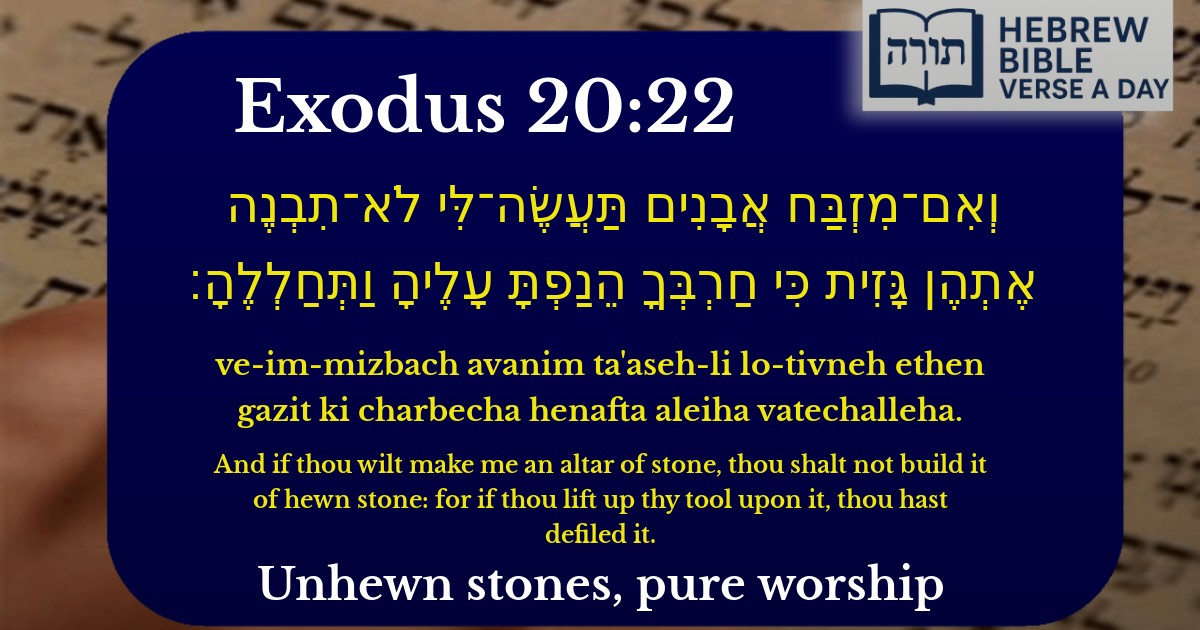Join Our Newsletter To Be Informed When New Videos Are Posted
Join the thousands of fellow Studends who rely on our videos to learn how to read the bible in Hebrew for free!
Hebrew Text
וְאִם־מִזְבַּח אֲבָנִים תַּעֲשֶׂה־לִּי לֹא־תִבְנֶה אֶתְהֶן גָּזִית כִּי חַרְבְּךָ הֵנַפְתָּ עָלֶיהָ וַתְּחַלְלֶהָ׃
English Translation
And if thou wilt make me an altar of stone, thou shalt not build it of hewn stone: for if thou lift up thy tool upon it, thou hast defiled it.
Transliteration
Ve-im-mizbach avanim ta'aseh-li lo-tivneh ethen gazit ki charbecha henafta aleiha vatechalleha.
Hebrew Leining Text
וְאִם־מִזְבַּ֤ח אֲבָנִים֙ תַּֽעֲשֶׂה־לִּ֔י לֹֽא־תִבְנֶ֥ה אֶתְהֶ֖ן גָּזִ֑ית כִּ֧י חַרְבְּךָ֛ הֵנַ֥פְתָּ עָלֶ֖יהָ וַתְּחַֽלְלֶֽהָ׃
Parasha Commentary
📚 Talmud Citations
This verse is quoted in the Talmud.
📖 Middot 3:4
The verse is referenced in the discussion about the construction of the altar in the Temple, emphasizing the prohibition against using hewn stones.
📖 Yoma 54a
The verse is cited in the context of discussing the sanctity of the altar and the materials used in its construction.


The Prohibition of Hewn Stones on the Altar
The verse (Shemot 20:22) prohibits constructing an altar from hewn stones (gazit), as using a metal tool (cherev) on the stones would defile them. Rashi explains that the altar's purpose is to lengthen human life, while metal tools (used in weapons) shorten life. Therefore, it is inappropriate to use an instrument of destruction on an object meant for peace and atonement.
Symbolism of Unhewn Stones
Rambam (Hilchot Beit HaBechirah 1:14) elaborates that the stones must remain in their natural state to reflect humility before Hashem. The altar represents service to G-d, which should be unadulterated by human arrogance. The Midrash Tanchuma (Terumah 11) adds that just as the stones are whole, so too should one's devotion be complete and unblemished.
The Defilement of Metal Tools
The Talmud (Middot 3:4) states that even if metal touches the stones without cutting them, it disqualifies them. The Kli Yakar emphasizes that metal, associated with war (as in cherev, sword), introduces a spirit of violence contrary to the altar's sanctity. This aligns with Yeshayahu 2:4, which envisions a future where weapons are repurposed for peace.
Practical Halachic Implications